Posted by: Northwest Eye in General on November 19, 2025
Introduction
Understanding sagging eyelids goes beyond just how we look; it’s about the emotional impact of aging, genetics, and lifestyle choices that can significantly affect our appearance and self-esteem. We understand that this can be a sensitive topic, and it’s common to feel concerned about how these changes might influence your confidence.
In this article, we’ll explore the various causes behind saggy eyelids. We aim to provide you with insights into both preventative measures and treatment options, whether you’re considering surgical or non-surgical solutions. It’s important to know that you’re not alone in this journey, and there are ways to address these concerns.
As you seek solutions to this common issue, you might wonder: how can you effectively combat the effects of sagging eyelids? With so many choices available, it can feel overwhelming. But rest assured, we are here to help you through this process, offering guidance and support every step of the way.
Explore the Causes of Sagging Eyelids
Sagging eyelids, medically referred to as ptosis, can be concerning, so it’s important to understand what might be causing these saggy eyelids. Several factors contribute to this condition:
-
Aging: As we age, our skin loses elasticity, and the muscles that support our eyelids can weaken, leading to drooping. This natural decline in muscle tone is a primary reason why many older adults have saggy eyelids.
-
Genetics: Your family background can significantly influence your chances of developing saggy eyelids. Genetic predisposition affects the structure and elasticity of saggy eyelids, making it a key factor to consider.
-
Medical Conditions: Certain conditions, like myasthenia gravis and Horner’s syndrome, can impact how the upper eyelid functions, resulting in saggy eyelids. These disorders affect the neuromuscular connections that control eyelid movement, often resulting in saggy eyelids, which can be frustrating and concerning.
-
Lifestyle Factors: Things like excessive sun exposure, smoking, and frequent eye rubbing can speed up the aging of your skin and result in saggy eyelids. Interestingly, research shows that women who wear hard contact lenses have a 20 times higher risk of developing saggy eyelids compared to those who don’t. Protecting your skin from UV rays and avoiding harmful habits can help mitigate these effects.
-
Injury or Surgery: If you’ve had previous eye surgeries or trauma around your eyes, it can lead to structural changes that result in sagging. These changes may affect the muscles and skin around your eyes, contributing to ptosis.
Clinically, ptosis is defined as a margin reflex distance (MRD) of 1.5 mm or less. Studies indicate that individuals with acquired ptosis tend to use hard contact lenses for significantly longer periods, suggesting a possible link between extended contact lens wear and drooping eyelids. In fact, 90.2% of patients with ptosis reported a history of wearing hard contact lenses, compared to just 31.6% of those without ptosis. This highlights the importance of being mindful of lifestyle choices when it comes to eye health.
Overall, saggy eyelids can be a complex issue influenced by a combination of aging, genetics, health conditions, and lifestyle factors. Understanding these contributing elements can empower you to take proactive steps in prevention and management. Remember, we are here to help you through this process.
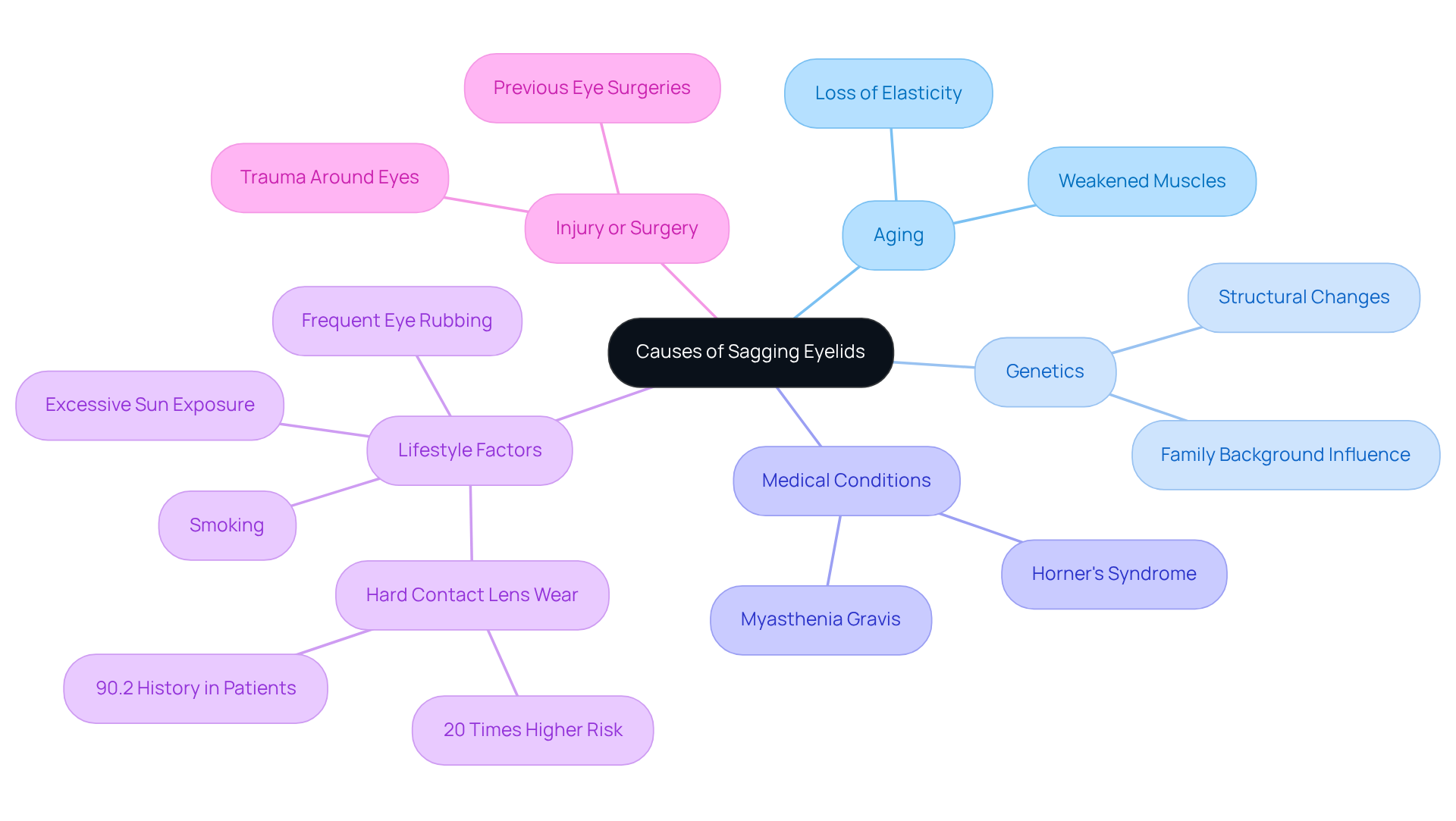
Implement Non-Surgical Preventative Strategies
To prevent or reduce the appearance of saggy eyelids, we understand that you may be looking for effective, non-surgical strategies. Here are some caring suggestions to help you on this journey:
-
Skincare: Consider incorporating products that contain retinoids and antioxidants. For instance, the Obagi Skin Care line is scientifically formulated to enhance skin elasticity and diminish fine lines. Obagi Professional-C® Products, which contain L-ascorbic acid, can strengthen your antioxidant defenses and promote a more youthful appearance. Remember, these products require a medical prescription. Research shows that retinoids can significantly improve texture and firmness over time. As Dr. Georgiana Donadio wisely states, “Your outer layer is the fingerprint of what is going on inside your body and all conditions related to it.” This highlights how crucial skincare is for your overall health.
-
Sun Protection: It’s common to feel concerned about the effects of UV rays on your skin. Consistently wearing sunscreen and sunglasses can protect the sensitive area around your eyes. Research indicates that daily sun protection can lower the risk of early aging by up to 80%. This statistic underscores the vital importance of sun protection in preserving a youthful appearance.
-
Healthy Lifestyle: Adopting a balanced diet rich in vitamins C and E, omega-3 fatty acids, and antioxidants can be beneficial. These nutrients are essential for maintaining the health of your dermis and can help combat oxidative stress that leads to saggy eyelids.
-
Hydration: We understand that staying hydrated is key. Make sure to drink plenty of water to keep your skin plump and elastic. Well-hydrated skin is less prone to sagging and fine lines.
-
Facial Exercises: Engaging in regular eye exercises can strengthen the muscles surrounding your eyes. Simple actions, like lifting your eyebrows and holding them for a few seconds, can improve muscle tone and help reduce saggy eyelids.
By incorporating these strategies into your daily routine, you can take proactive steps toward preserving the health and appearance of your eyes. Remember, we are here to help you through this process.
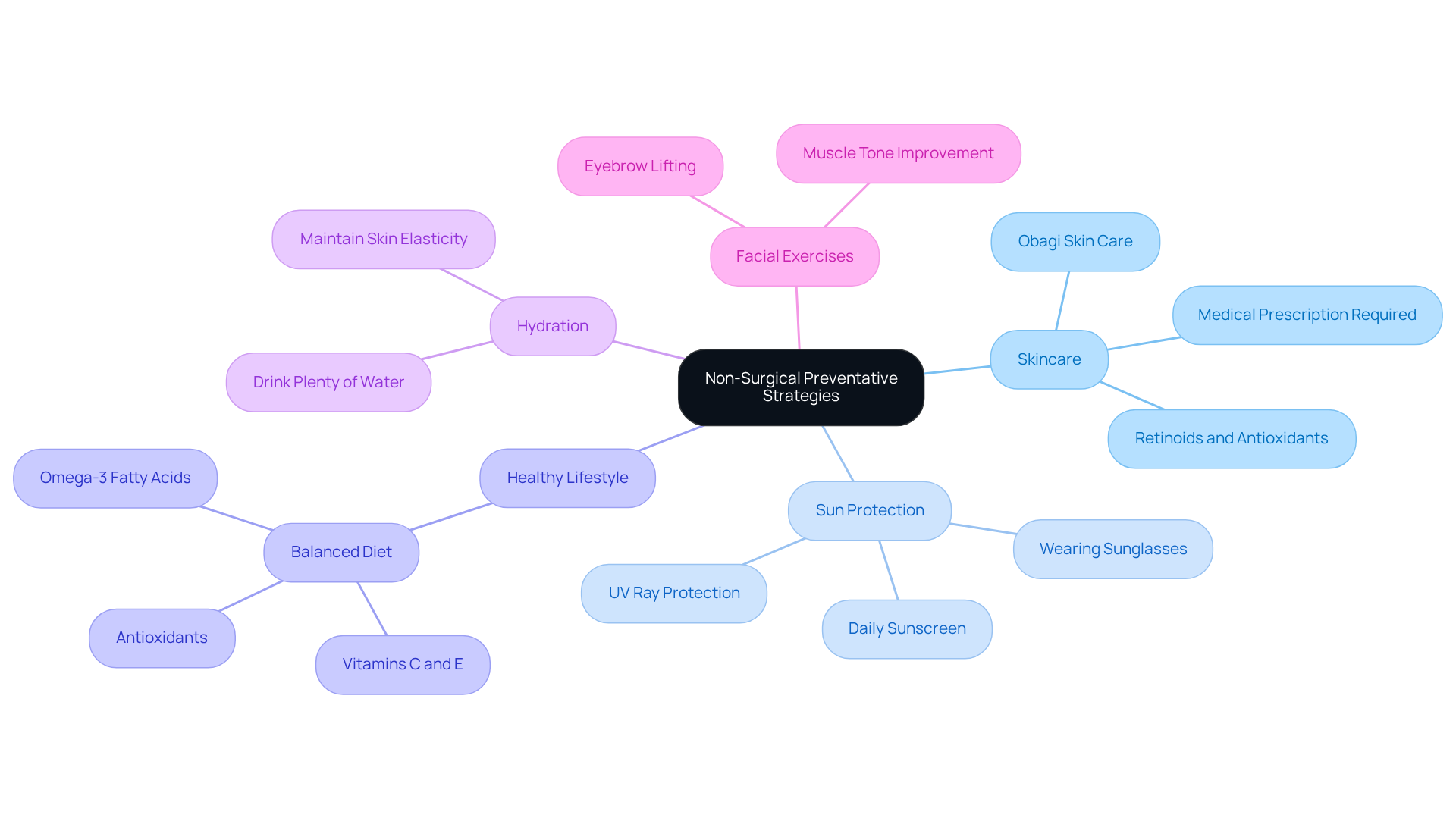
Evaluate Surgical Solutions for Sagging Eyelids
When non-surgical approaches fall short, surgical options can provide a viable solution for those struggling with saggy eyelids. We understand that this can be a concerning issue, and we’re here to help you navigate your choices. Here are some of the most common procedures:
-
Blepharoplasty: This surgical technique effectively removes excess skin and fat from the eyelids, enhancing both aesthetic appeal and functional capability. It can be performed on either the upper or lower eyelids to refresh the eye region and reduce saggy eyelids while preserving the natural contour. Many patients report a boost in confidence in both professional and social settings after surgery, often feeling more rested and open in their expressions.
-
Ptosis Repair: This procedure focuses on tightening the muscles that elevate the upper eyelid, making it particularly beneficial for individuals with saggy eyelids that affect their vision. Ideal candidates typically show measurable saggy eyelids, which impact peripheral vision. If you meet specific criteria, such as a visual field loss of 30% or greater, insurance coverage may apply.
-
Recovery Considerations: We know that post-operative care is crucial for a smooth recovery. Patients can expect some swelling and bruising, which usually subsides within a few weeks. Initially, rest and cold compresses can help minimize bruising during the first 48 hours. Follow-up appointments are essential, typically scheduled at one week, one month, and three months post-surgery. These visits allow experienced oculoplastic surgeons to monitor your healing progress and address any concerns. Most patients find the recovery experience more comfortable than they anticipated, often managing discomfort with over-the-counter pain relievers. Many return to contact lens use within two weeks after blepharoplasty. By the third month, the final results of your eye surgery will become evident, marking the achievement of your desired aesthetic outcomes.
We are here to support you through this process, ensuring you feel informed and cared for every step of the way.
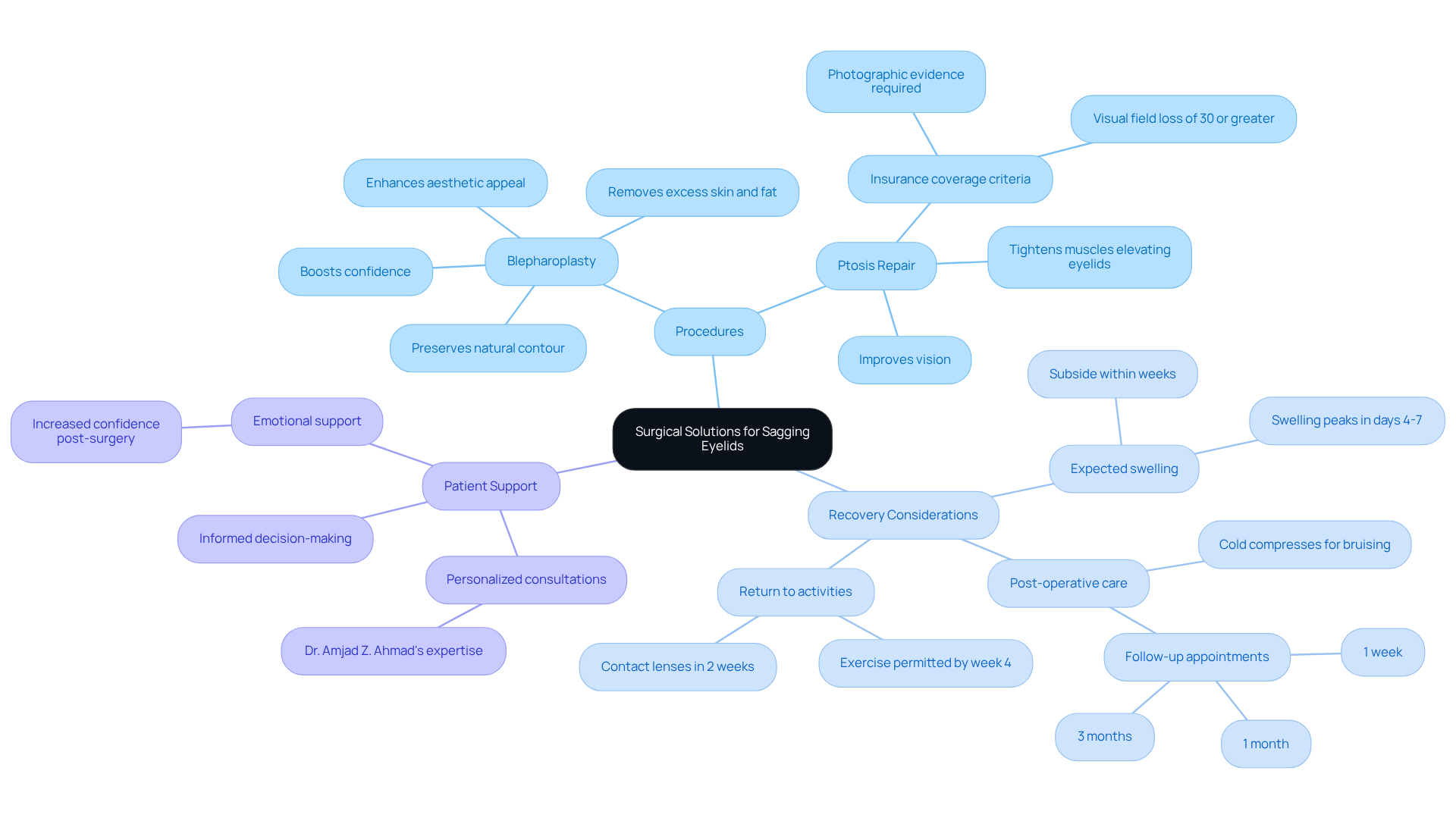
Understand the Role of Lifestyle Factors
Several lifestyle factors can significantly contribute to the development of saggy eyelids, and we understand how concerning this can be. Let’s explore some of these factors together:
-
Diet: A diet rich in processed foods and sugars can lead to inflammation and accelerate skin aging. By focusing on whole foods-like fruits, vegetables, and healthy fats-you can enhance your overall health and appearance.
-
Hydration: Dehydration can make your skin appear dull and saggy. Ensuring you drink enough water daily is crucial for preserving the elasticity and vibrancy of your complexion.
-
Sleep: It’s common to feel the effects of inadequate sleep quality, which can lead to puffiness and saggy eyelids. Establishing a consistent sleep schedule and ensuring you get enough rest can help mitigate these effects.
-
Smoking and Alcohol: Both smoking and excessive alcohol consumption are known to speed up the aging of your complexion. Quitting smoking and reducing alcohol intake can lead to noticeable improvements in your skin’s health and overall appearance.
-
Stress Management: Chronic stress can adversely affect your skin’s health. Incorporating stress-reducing practices such as yoga, meditation, or regular exercise can enhance your skin’s vitality and reduce the likelihood of developing saggy eyelids.
We are here to help you through this process, and making these lifestyle changes can lead to positive outcomes for your skin.
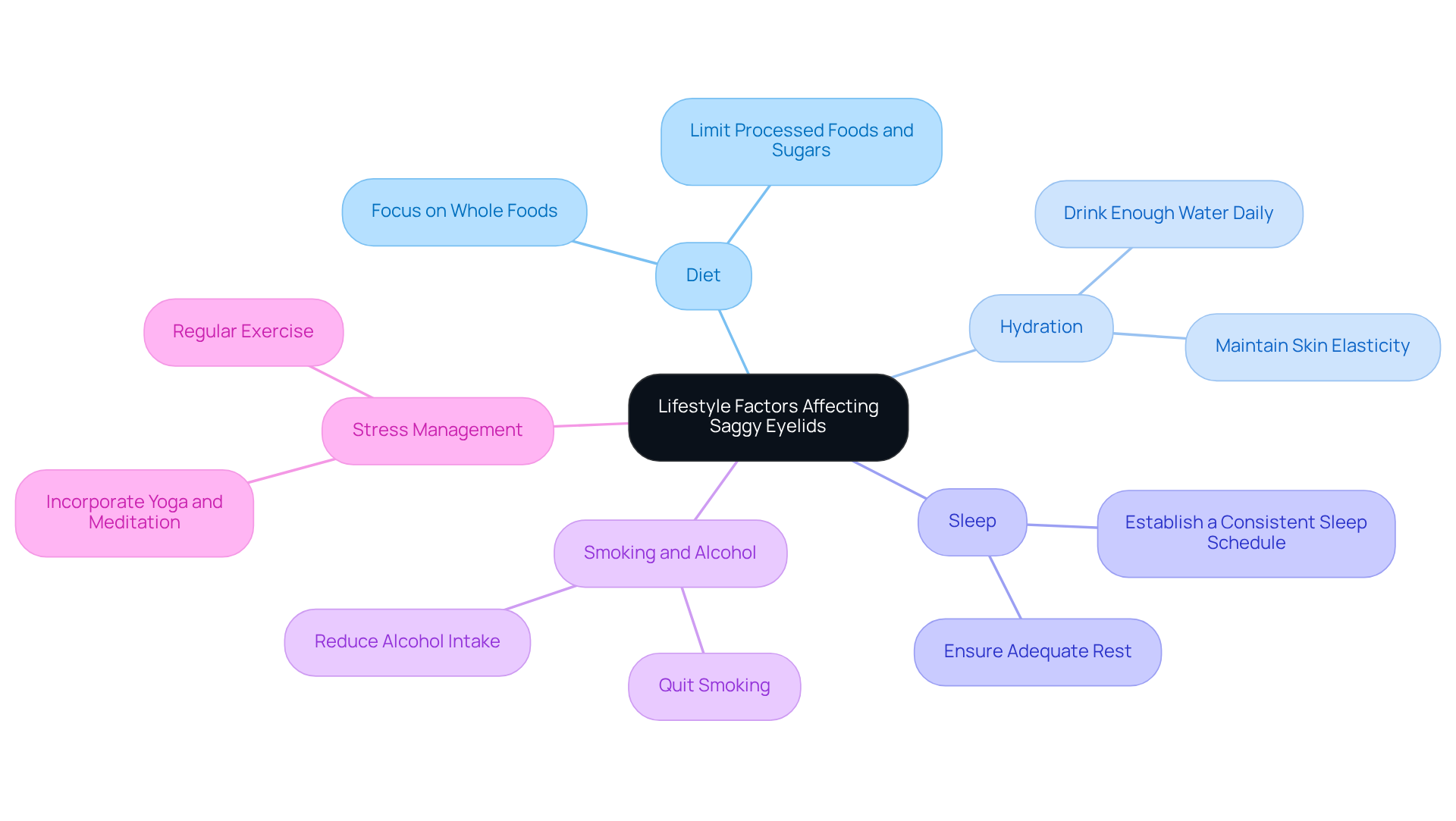
Explore Non-Invasive Treatments
If you’re feeling concerned about saggy eyelids, you’re not alone. Many people seek non-invasive solutions to address the common issue of saggy eyelids. Here are some treatments that might help:
- Botox: These injections can provide a temporary lift by relaxing the muscles around your eyes, helping you feel more refreshed.
- Dermal Fillers: By adding volume to the area around your eyes, fillers can significantly reduce the appearance of saggy eyelids, resulting in a more youthful look.
- Laser Treatments: This therapy tightens the skin’s surface and enhances elasticity, which can rejuvenate your appearance.
- Radiofrequency Treatments: These procedures stimulate collagen production, aiding in firming and lifting the area around saggy eyelids, which can be quite reassuring.
- Topical Treatments: Creams with peptides and growth factors can improve skin texture and firmness over time, offering a gentle solution.
- Obagi Skin Care: This scientifically formulated range targets aging concerns like dark spots and hyperpigmentation. Obagi Professional-C® Products, rich in L-ascorbic acid, help bolster your skin’s antioxidant defenses for a youthful glow. Plus, Obagi’s retinol products specifically address fine lines and wrinkles.
We understand that navigating these options can feel overwhelming. A consultation with Dr. Schmitt can provide personalized insights on how Obagi’s innovative products can complement your treatment plan, ensuring you feel supported every step of the way.
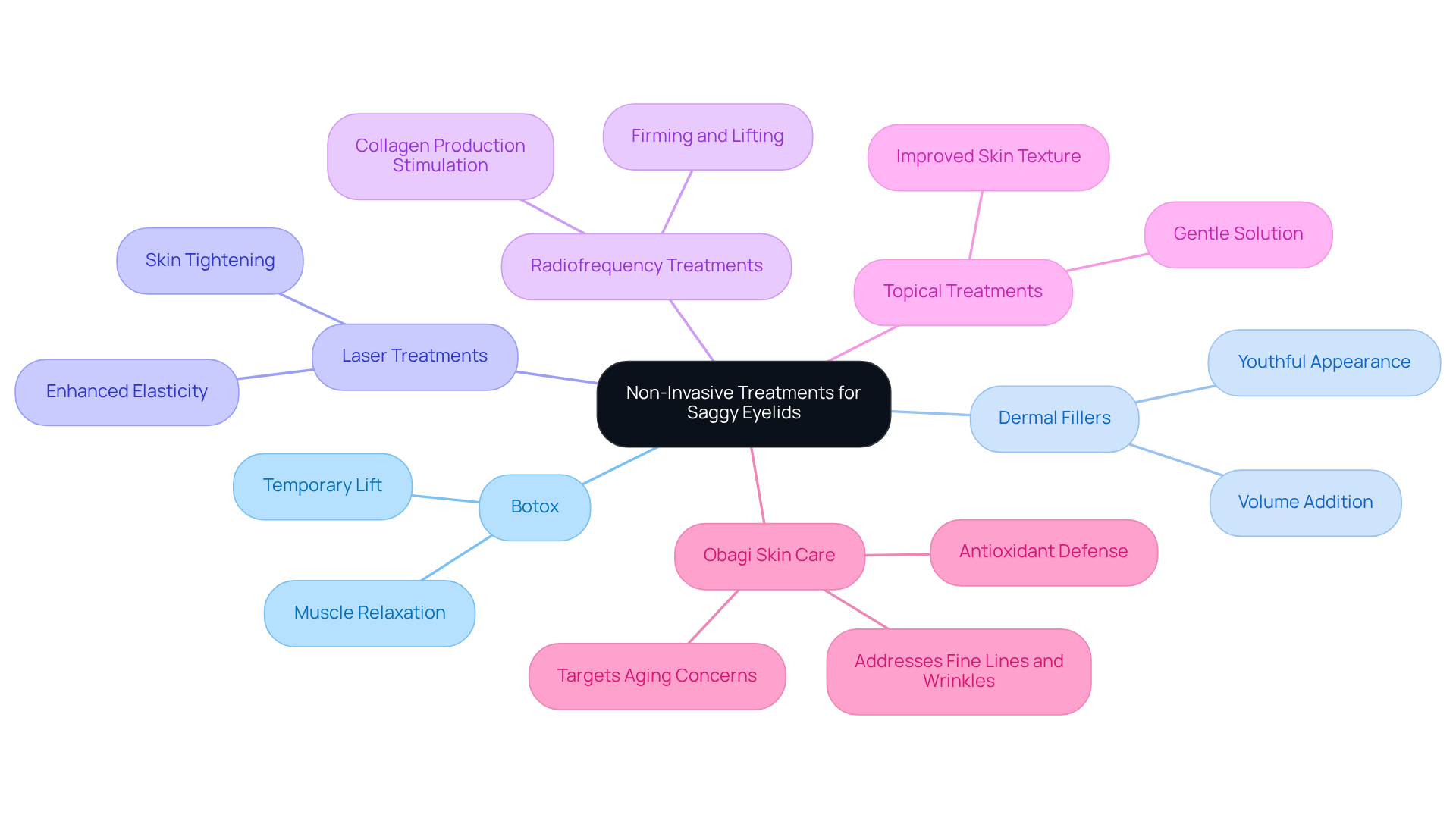
Conclusion
Understanding saggy eyelids can be overwhelming, and we recognize the emotions that come with this concern. It’s important to know that the causes are multifaceted, influenced by aging, genetics, medical conditions, lifestyle choices, and even past injuries or surgeries. By identifying these factors, you can take meaningful steps to manage and prevent sagging eyelids.
Key insights from our discussion highlight the importance of both non-surgical and surgical options. Non-invasive treatments, such as:
- Skincare products
- Sun protection
- A healthy diet
- Hydration
- Facial exercises
can significantly improve eyelid firmness and overall appearance. If these methods aren’t enough, surgical solutions like:
- Blepharoplasty
- Ptosis repair
offer viable alternatives for those seeking more dramatic results. Understanding recovery considerations and the potential benefits of each approach is essential for making informed decisions.
Ultimately, addressing saggy eyelids is not just about aesthetics; it reflects a broader commitment to your overall health and well-being. By embracing preventative measures and exploring available treatments, you can enhance your confidence and maintain a youthful appearance. Taking action now-whether through lifestyle adjustments or consulting with professionals about treatment options-can lead to positive outcomes for both your eye health and self-image. Remember, we are here to help you through this process.
Frequently Asked Questions
What are sagging eyelids, and what is the medical term for them?
Sagging eyelids, medically referred to as ptosis, occur when the eyelids droop due to various factors.
What are the main causes of sagging eyelids?
The main causes of sagging eyelids include aging, genetics, medical conditions, lifestyle factors, and past injuries or surgeries.
How does aging affect eyelids?
As we age, the skin loses elasticity, and the muscles supporting the eyelids weaken, leading to drooping.
Can genetics influence the development of sagging eyelids?
Yes, genetic predisposition can significantly affect the structure and elasticity of eyelids, increasing the likelihood of sagging.
What medical conditions are associated with sagging eyelids?
Conditions such as myasthenia gravis and Horner’s syndrome can impact eyelid function and contribute to sagging.
How do lifestyle factors contribute to sagging eyelids?
Excessive sun exposure, smoking, and frequent eye rubbing can accelerate skin aging, leading to sagging. Wearing hard contact lenses is also linked to a higher risk of developing saggy eyelids.
What is the clinical definition of ptosis?
Clinically, ptosis is defined as a margin reflex distance (MRD) of 1.5 mm or less.
What non-surgical strategies can help prevent or reduce sagging eyelids?
Non-surgical strategies include skincare (using retinoids and antioxidants), sun protection, maintaining a healthy lifestyle, staying hydrated, and performing facial exercises.
Why is skincare important for preventing sagging eyelids?
Skincare products containing retinoids and antioxidants can improve skin elasticity and texture, which is crucial for overall eye health.
How does sun protection help in preventing sagging eyelids?
Wearing sunscreen and sunglasses can protect the sensitive skin around the eyes from UV rays, reducing the risk of early aging by up to 80%.
What dietary factors can help maintain eyelid health?
A balanced diet rich in vitamins C and E, omega-3 fatty acids, and antioxidants can support skin health and combat oxidative stress.
How does hydration affect the appearance of eyelids?
Staying well-hydrated helps keep the skin plump and elastic, making it less prone to sagging and fine lines.
What are some facial exercises that can benefit eyelid appearance?
Regular eye exercises, such as lifting the eyebrows and holding them for a few seconds, can strengthen the surrounding muscles and help reduce sagging.






